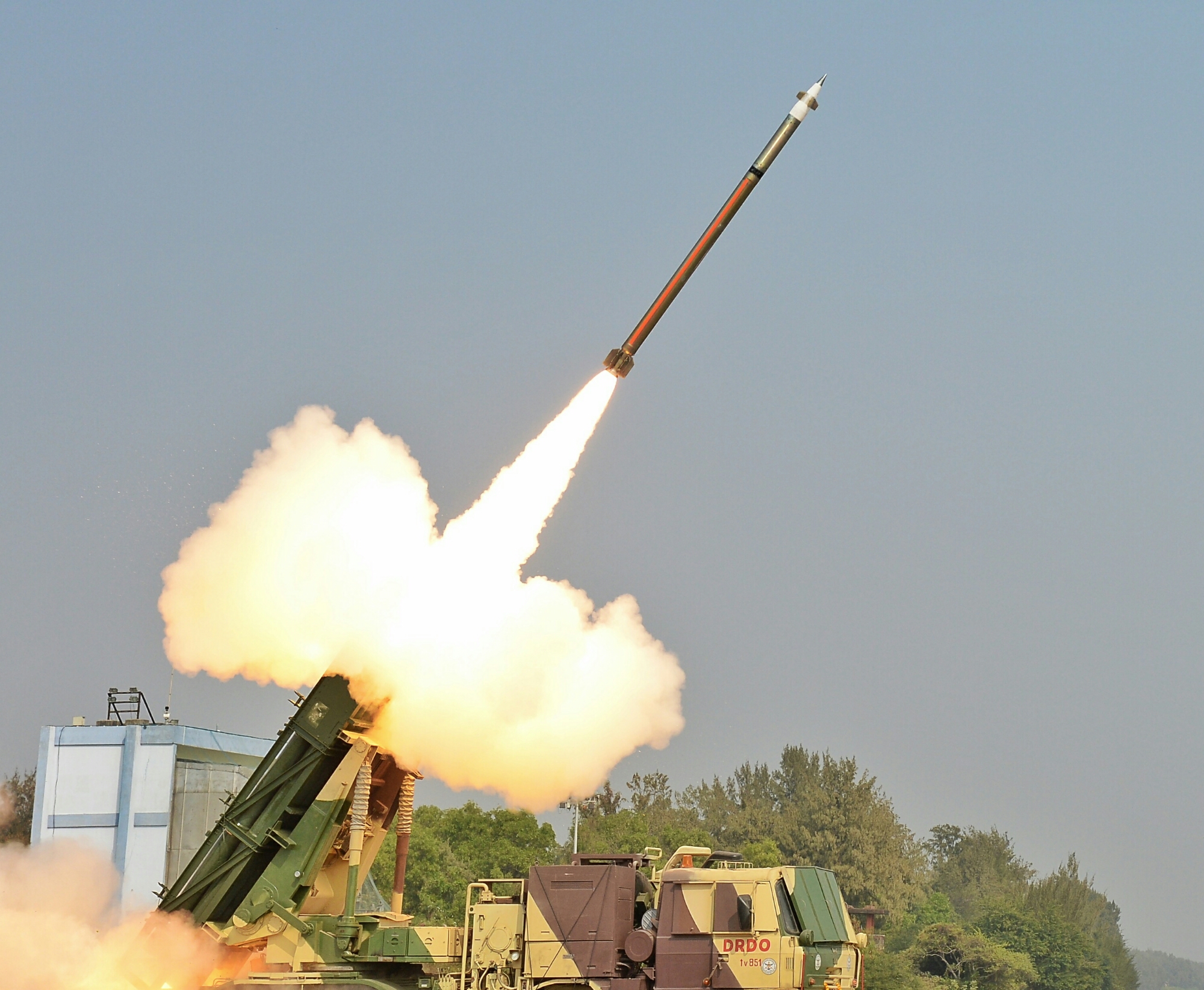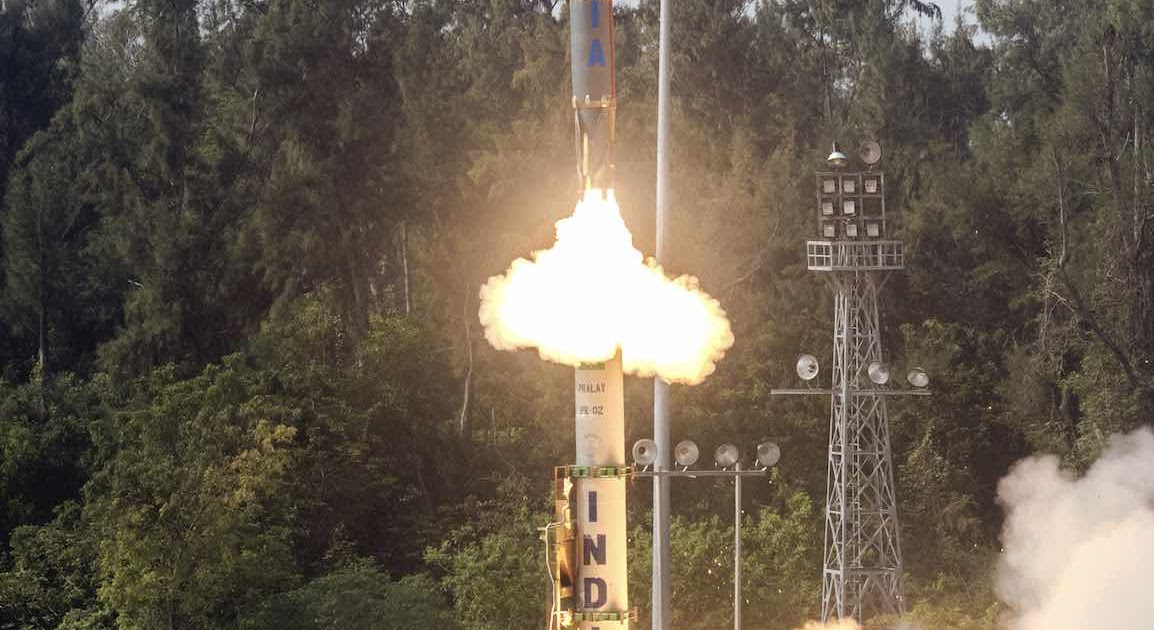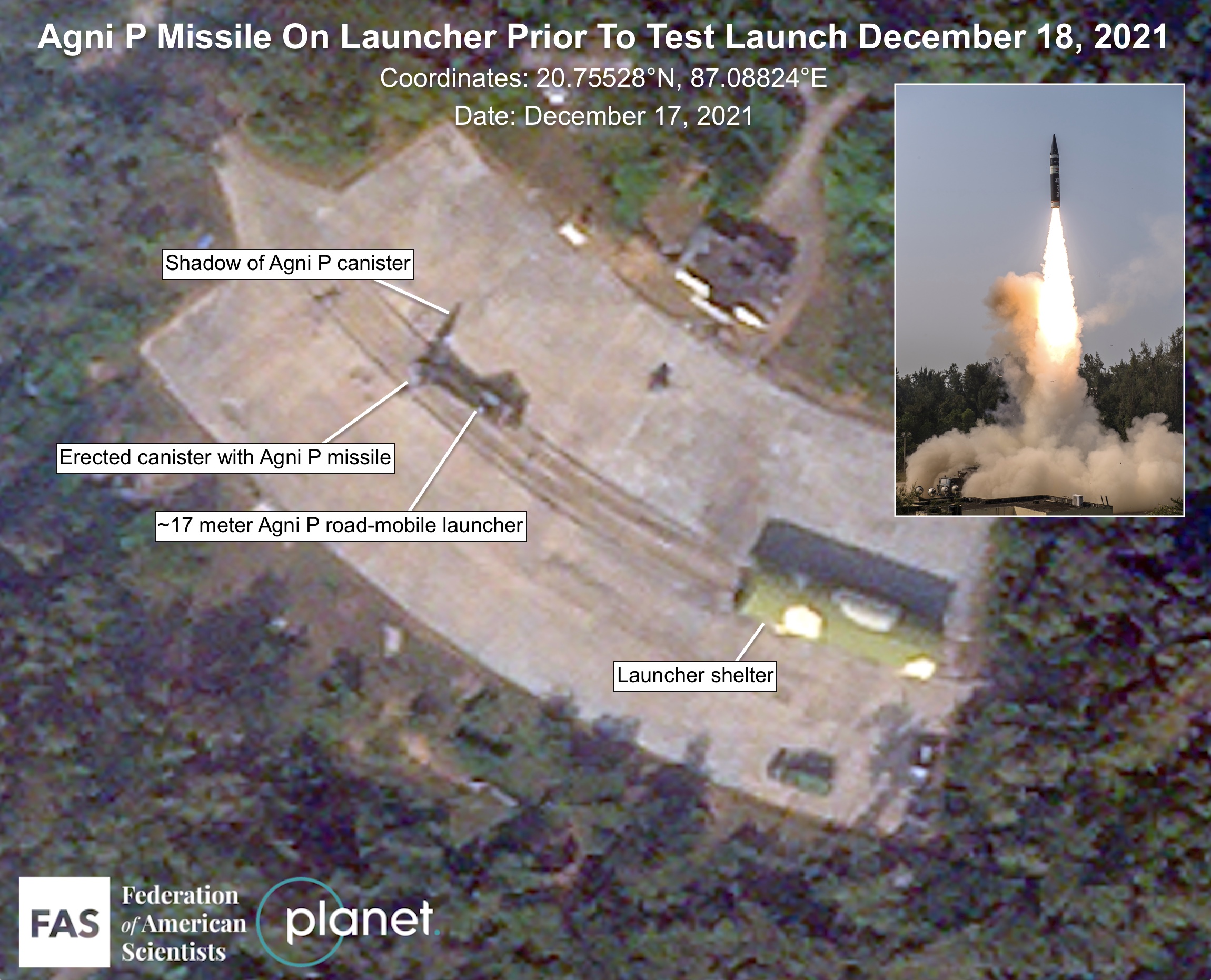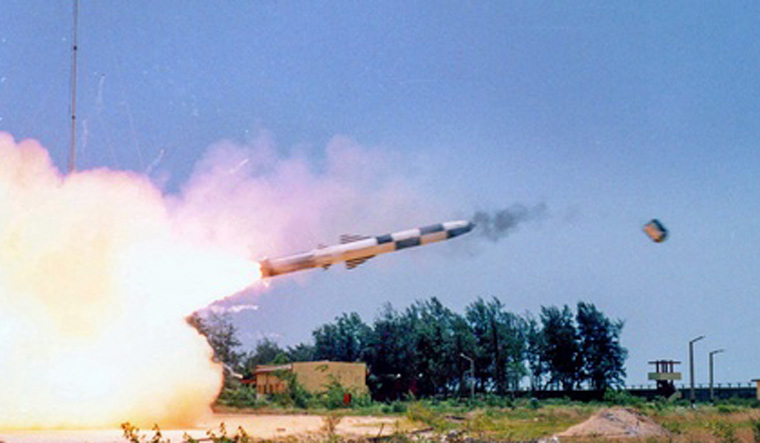Continuing the steady modernization of India’s missile arsenal, both conventional and nuclear-tipped, the Defence R&D Organisation (DRDO) conducted on Wednesday the maiden launch of an indigenous, new-generation, surface-to-surface missile called “Pralay.”
DRDO officials are categorically stating that the Pralay will not be part of India’s nuclear deterrent. Instead, like the earlier Shourya and Prahar missiles, the Pralay is powered by conventional solid fuel, and its payload is designed to carry only a conventional warhead. “It (Pralay) is powered by a solid propellant rocket motor and many new technologies. The missile has a range of 150-500 kilometres and can be launched from a mobile launcher,” said a ministry of defence (MoD) statement after the test.

Pralay PR-02 (second test article) ejects from canister, fins yet to deploy - can be seen in folded-down form

Pralay PR-02 boosts up, control fins fully deployed. The Thrust-Vector Control (TVC) vanes on the Nozzle can also be seen. Combination of TVC + Fins likely imparts a high degree of maneuverability to the system straight from boost phase, inside the atmosphere.
“The mission has met all its objectives. The missile followed the desired quasi-ballistic trajectory and reached the designated target with a high degree of accuracy, validating control, guidance and mission algorithms. All the sensors deployed, including down range ships, tracked the missile trajectory and captured all the events,” stated the MoD.

The Pralay SRBM is likely the first all-new missile system for which the recently-commissioned missile telemetry-tracking ship INS Dhruv (VC-11184) has played a part in gathering accurate terminal-stage test data right from the start - further refining the testing process
Top DRDO officials, such as the organization's former Director-General VK Saraswat, said the development of the new missiles had multiple objectives. These included: “Bridging the [range] gap between the Pinaka multi-barrel rocket launcher (MBRL) system and the Prithvi missiles.” The indigenous Pinaka MBRL strikes targets up to 60-70 km from the launchers; while variants of the Prithvi missile can flatten objectives 250-350 km away. The territory between them, where key targets will be located in wartime, will be engaged by the Shourya, Prahar and Pralay missile systems.

Pinaka 214mm MBRL on a previous test. This version of the round has a Precision Guidance Kit (PGK) on the nose, enhancing accuracy
Two US academics who specialize in South Asia, Christopher Clary and Vipin Narang, have enumerated the targets these surface-to-surface, short-range missile systems would be used to strike within Pakistan. The Prahar can strike all three of the Pakistan Army’s service headquarters and four of its nine corps headquarters, which are all located within 150 kilometers of the border. So are two of the Pakistan Air Force’s eleven “deploying bases,” as well as its joint staff and the Strategic Plans Division that controls Pakistan’s nuclear arsenal.
The Shourya missile, a land-based version of the Indian Navy’s underwater Sagarika missile, with a range of 750 km, can reach every one of Pakistan’s 20 largest cities, all of the Pakistan Air Force’s flying bases, every corps command location, and the Pakistan Navy’s two most important ports, Karachi and Ormara.

K-15/B-05 Submarine-launched Missile (SLBM) - The Shourya (also written Shaurya) is the land-based version of this system. Shaurya was reportedly deployed during the recent tensions with China.
Even so, speculation continues about a possible nuclear role for the three missiles. These are fueled partially by reports that Prahar missiles are being manufactured and inducted into service to replace all of India’s 150-kilometer Prithvi ballistic missiles -- which were themselves deemed to be dual-use weapons.

Prithvi-II liquid-fueled SRBM - the Prithvi-series was originally designed & developed in the 1980s, the first to have been done so under India's Integrated Guided Missile Development Program (IGMDP). The original Prithvi-I has already been retired. The induction of Pralay will probably retire the newer versions as well.
The MoD has announced that the “Pralay missile is powered with a solid propellant rocket motor and many new technologies. The missile… can be launched from a mobile launcher. The missile guidance system includes state-of-the-art navigation system and integrated avionics."

 www.ajaishukla.com
www.ajaishukla.com
DRDO officials are categorically stating that the Pralay will not be part of India’s nuclear deterrent. Instead, like the earlier Shourya and Prahar missiles, the Pralay is powered by conventional solid fuel, and its payload is designed to carry only a conventional warhead. “It (Pralay) is powered by a solid propellant rocket motor and many new technologies. The missile has a range of 150-500 kilometres and can be launched from a mobile launcher,” said a ministry of defence (MoD) statement after the test.
Pralay PR-02 (second test article) ejects from canister, fins yet to deploy - can be seen in folded-down form
Pralay PR-02 boosts up, control fins fully deployed. The Thrust-Vector Control (TVC) vanes on the Nozzle can also be seen. Combination of TVC + Fins likely imparts a high degree of maneuverability to the system straight from boost phase, inside the atmosphere.
“The mission has met all its objectives. The missile followed the desired quasi-ballistic trajectory and reached the designated target with a high degree of accuracy, validating control, guidance and mission algorithms. All the sensors deployed, including down range ships, tracked the missile trajectory and captured all the events,” stated the MoD.
The Pralay SRBM is likely the first all-new missile system for which the recently-commissioned missile telemetry-tracking ship INS Dhruv (VC-11184) has played a part in gathering accurate terminal-stage test data right from the start - further refining the testing process
Top DRDO officials, such as the organization's former Director-General VK Saraswat, said the development of the new missiles had multiple objectives. These included: “Bridging the [range] gap between the Pinaka multi-barrel rocket launcher (MBRL) system and the Prithvi missiles.” The indigenous Pinaka MBRL strikes targets up to 60-70 km from the launchers; while variants of the Prithvi missile can flatten objectives 250-350 km away. The territory between them, where key targets will be located in wartime, will be engaged by the Shourya, Prahar and Pralay missile systems.

Pinaka 214mm MBRL on a previous test. This version of the round has a Precision Guidance Kit (PGK) on the nose, enhancing accuracy
Two US academics who specialize in South Asia, Christopher Clary and Vipin Narang, have enumerated the targets these surface-to-surface, short-range missile systems would be used to strike within Pakistan. The Prahar can strike all three of the Pakistan Army’s service headquarters and four of its nine corps headquarters, which are all located within 150 kilometers of the border. So are two of the Pakistan Air Force’s eleven “deploying bases,” as well as its joint staff and the Strategic Plans Division that controls Pakistan’s nuclear arsenal.
The Shourya missile, a land-based version of the Indian Navy’s underwater Sagarika missile, with a range of 750 km, can reach every one of Pakistan’s 20 largest cities, all of the Pakistan Air Force’s flying bases, every corps command location, and the Pakistan Navy’s two most important ports, Karachi and Ormara.
K-15/B-05 Submarine-launched Missile (SLBM) - The Shourya (also written Shaurya) is the land-based version of this system. Shaurya was reportedly deployed during the recent tensions with China.
Even so, speculation continues about a possible nuclear role for the three missiles. These are fueled partially by reports that Prahar missiles are being manufactured and inducted into service to replace all of India’s 150-kilometer Prithvi ballistic missiles -- which were themselves deemed to be dual-use weapons.
Prithvi-II liquid-fueled SRBM - the Prithvi-series was originally designed & developed in the 1980s, the first to have been done so under India's Integrated Guided Missile Development Program (IGMDP). The original Prithvi-I has already been retired. The induction of Pralay will probably retire the newer versions as well.
The MoD has announced that the “Pralay missile is powered with a solid propellant rocket motor and many new technologies. The missile… can be launched from a mobile launcher. The missile guidance system includes state-of-the-art navigation system and integrated avionics."
Pralay missile successfully launched, raising Indian options
++++
Following the initial test on Dec 22nd, a second test of the missile system took place the following day on Dec 23rd. The MoD report stated that a different payload fraction & range envelope were validated in the second test.
Following the initial test on Dec 22nd, a second test of the missile system took place the following day on Dec 23rd. The MoD report stated that a different payload fraction & range envelope were validated in the second test.
Last edited:






